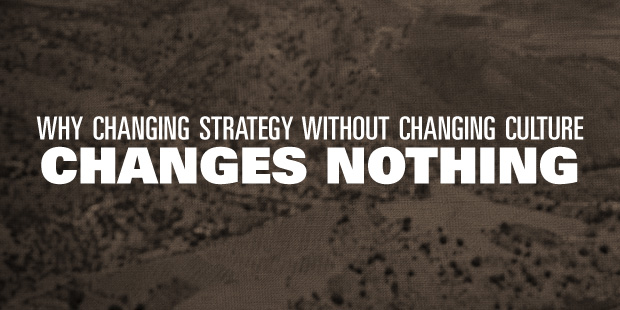
Why Changing Strategy Without Changing Culture Changes Nothing
I see it almost everywhere I work with leadership teams. Let me tell you what it is and what you should be doing differently. And I will cite two great HBR articles that are helpful. (For more about HBR go here.)
Before I name the mistake, let me describe how it pops up.
You want to move ahead so you brainstorm a bit, read the latest books, review all the models, attend a conference or watch some videos. Then draft the new strategy, delegate responsibilities, and launch the new plan.
And in six months you are…
- Spinning Your Wheels. Lots of vision and planning is done, and even some keenly designed initiatives, but you seem to be spinning your wheels and getting nowhere. Why?
- Driving on the Wrong Track. You get off to a fast start, launch an initiative, and soon leaders start moving, building teams and creating materials … but there is confusion. Why is this not working? You’re going somewhere — but where?
- Having a Multiple-Vehicle Accident. Your entrepreneurial team starts launching their own version of the vision, building and designing what works for them, running into one another as they fight for people, recognition, platform and resources. Soon there’s a 6-leader pileup.
These leaders had great strategies, good people and ample resources. But they kept failing. What needed to change?
Culture.
When you change your strategy without changing your culture, you change NOTHING! Change is resisted at every bend. Here are ten reasons why.
So why amplify this reality by putting new wine in old wine skins? Or, to stick with our racing metaphor, we strap a formula-one engine to a NASCAR chassis. It makes a lot of noise and covers a lot of ground – but nothing really changes.
- A university creates online programming to make more content available – but they don’t change delivery methods, relying on a teacher-centered model instead of a learner-centered approach.
- A church wants a new outreach strategy and launches new “missional communities,” but the congregation does not have a missional mindset, and they really don’t understand the people they are trying to reach.
- A business hires phone “consultants” for that “personal touch” to improve customer service. But actually what the customer wants is speedy ordering, distinctive choices and an easy internet-based return policy – they do not need a nice phone conversation.
In the popular Lean Start-Up Movement, entrepreneurs re-think the way we launch a venture (or ministry or educational center, etc.). Listen to Steve Blank on Lean Start-ups:
…it favors experimentation over elaborate planning, customer feedback over intuition, and iterative design over traditional “big design up front” development. Although the methodology is just a few years old, its concepts—such as “minimum viable product” and “pivoting”—have quickly taken root in the start-up world, and business schools have already begun adapting their curricula to teach them.
This approach is working because it forces you to actually understand the culture you are trying to reach, and the culture you are creating in your own camp.
It is not enough to change a strategy or talk about innovation. Cultures must change. I spend lots of time helping teams and leaders make progress here. Here are some questions that drive that process.
- What defines us now – who are we really?
- Where do we want to go and why?
- What exits in the new culture we want to create that is absent now?
- What kind of leaders do we need to become to make this transition?
- What environments, tools and processes need to be created (or removed) in order to move toward the future?
- Do we have/can we get the right people?
- What actual steps are required and who is responsible for each one?
- How do we know we are making progress?
- How hard are we willing to work to change our culture?
Leaders are in the culture-making business. Before you take the “big splash” approach again, you might evaluate the culture…inside and out. That means changing how you view potential leaders, the systems you design, the people you recruit or hire, the process (not just the end result) of how you develop strategy, and whether you become learners rather than teachers.
So what’s in your culture?
What will it take for a cultural makeover?
What are your biggest challenges in culture shaping and culture changing?
>> Read more from Bill here.

Tags: Bill Donahue, Change, Culture, Leadership Engine, Organizational Culture











